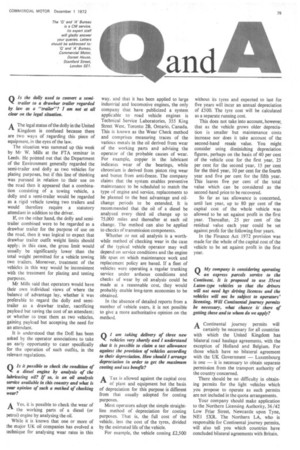Q I am taking delivery of three new vehicles very shortly
Page 81

If you've noticed an error in this article please click here to report it so we can fix it.
and I understand that it is possible to claim a tax allowance against the provision of vehicles according to their depreciation. How should I arrange depreciation in order to get the maximum costing and tax benefit?
A Tax is allowed against the capital cost
of plant and equipment but the basis of depreciation for this purpose is different from that usually adopted for costing purposes.
Most operators adopt the simple straightline method of depreciation for costing purposes. That is, the full cost of the vehicle, less the cost of the tyres, divided by the estimated life of the vehicle.
For example, the vehicle costing £2,500 without its tyres and expected to last for five years will incur an annual depreciation of £500. The tyre cost will be calculated as a separate running cost.
This does not take into account, however, that as the vehicle grows older depreciation is smaller but maintenance costs increase nor does it take account of the second-hand resale value. You might consider using diminishing depreciation figures, perhaps on the basis of 40 per cent of the vehicle cost for the first year, 25 per cent for the second year, 15 per cent for the third year, 10 per cent for the fourth year and five per cent for the fifth year. This leaves five per cent of the total value which can be considered as the second-hand price to be recovered.
So far as tax allowance is concerned, until last year, up to 80 per cent of the capital cost of the whole vehicle was allowed to be set against profit in the first year. Thereafter, 25 per cent of the residual value each year could be set against profit for the following four years.
In the Finance Act 1972 provision was made for the whole of the capital cost of the vehicle to be set against profit in the first year.
































































































































